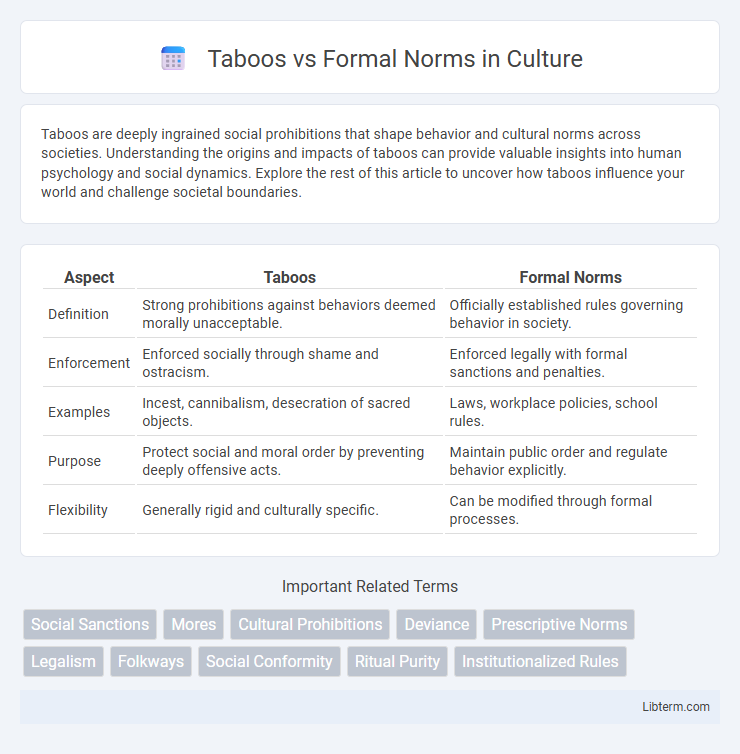Taboos are deeply ingrained social prohibitions that shape behavior and cultural norms across societies. Understanding the origins and impacts of taboos can provide valuable insights into human psychology and social dynamics. Explore the rest of this article to uncover how taboos influence your world and challenge societal boundaries.
Table of Comparison
| Aspect | Taboos | Formal Norms |
|---|---|---|
| Definition | Strong prohibitions against behaviors deemed morally unacceptable. | Officially established rules governing behavior in society. |
| Enforcement | Enforced socially through shame and ostracism. | Enforced legally with formal sanctions and penalties. |
| Examples | Incest, cannibalism, desecration of sacred objects. | Laws, workplace policies, school rules. |
| Purpose | Protect social and moral order by preventing deeply offensive acts. | Maintain public order and regulate behavior explicitly. |
| Flexibility | Generally rigid and culturally specific. | Can be modified through formal processes. |
Understanding Taboos: Definition and Examples
Taboos are powerful social prohibitions that forbid specific behaviors, often rooted in deep cultural or moral beliefs, such as incest or cannibalism. These norms carry strong emotional reactions and sanctions, distinguishing them from formal norms, which are codified laws or regulations enforced by official authorities. Understanding taboos involves recognizing their role in shaping social order by preventing actions considered inherently harmful or offensive within a society.
What are Formal Norms? Key Characteristics
Formal norms are established rules and laws explicitly created and enforced by institutions to regulate behavior within a society. Key characteristics include codification in written form, clear consequences for violations, and official enforcement by authorized bodies such as the government or legal system. These norms maintain social order by providing predictable and standardized guidelines for conduct.
The Sociological Roots of Taboos
Taboos arise from deep-seated sociological roots embedded in collective values, social cohesion, and cultural identity, often serving to protect community integrity by prohibiting actions deemed morally or spiritually harmful. These prohibitions are more intense than formal norms because violating taboos can result in severe social sanctions or ostracism, reflecting their foundational role in maintaining societal order. Unlike formal norms codified in laws, taboos function as unwritten social rules that reinforce group solidarity and transmit cultural heritage across generations.
The Role of Formal Norms in Society
Formal norms establish clear, codified rules that regulate behavior within society, ensuring order and predictability through written laws and regulations. They provide a framework for resolving conflicts, maintaining social control, and promoting fairness by applying consistent standards across individuals and institutions. Enforcement mechanisms such as judicial systems and government agencies are vital in upholding these norms, reinforcing societal stability and cohesion.
Comparing Taboos and Formal Norms: Key Differences
Taboos are deeply ingrained social prohibitions rooted in moral beliefs, often unspoken but strongly enforced by societal outrage, while formal norms are explicit rules codified in laws or regulations with clear legal consequences. Taboos regulate behavior by appealing to emotional and cultural values, whereas formal norms rely on institutional authority and formal sanctions to ensure compliance. The violation of taboos typically provokes social ostracism, while breaking formal norms results in legal penalties such as fines, imprisonment, or other official punishments.
Social Functions: Why Taboos and Formal Norms Exist
Taboos and formal norms exist to regulate social behavior by establishing boundaries that maintain order and cohesion within communities. Taboos prohibit actions considered deeply offensive or harmful, ensuring societal survival and moral integrity. Formal norms provide explicit rules and consequences to govern interactions, facilitating predictability and cooperation in complex social structures.
Cultural Variations in Taboos and Formal Norms
Cultural variations in taboos and formal norms significantly shape social behavior and expectations within different societies. Taboos often reflect deep-seated cultural beliefs, such as dietary restrictions in Hinduism or prohibitions on discussing death in Japanese culture, while formal norms are codified rules like legal regulations or dress codes that vary between countries and communities. Understanding these differences is crucial for effective intercultural communication and avoiding social misunderstandings in global contexts.
Consequences of Breaking Taboos vs Formal Norms
Breaking taboos often results in severe social ostracism and deep cultural stigma due to their intrinsic moral and emotional weight within a community. Violating formal norms, such as laws or organizational rules, typically triggers legal penalties, fines, or official sanctions enforced by governing bodies. Taboos invoke informal social consequences rooted in collective values, while formal norm breaches lead to structured legal or institutional responses.
Changing Taboos and Evolving Formal Norms
Taboos, deeply rooted prohibitions often tied to cultural identity, transform slowly but reflect shifting societal values when altered, such as changing attitudes toward previously taboo subjects like same-sex relationships. Formal norms, codified through laws and regulations, evolve more systematically through legislative updates and judicial interpretations, exemplified by the legalization of marijuana in various states. Both evolving taboos and formal norms demonstrate society's dynamic adaptation to new ethical standards and social priorities.
The Impact of Taboos and Formal Norms on Social Order
Taboos and formal norms both play crucial roles in maintaining social order by regulating behavior and defining acceptable conduct within societies. Taboos, deeply ingrained prohibitions often linked to cultural or religious beliefs, evoke strong emotional responses and help prevent actions considered morally repugnant, thereby protecting group cohesion. Formal norms, codified laws and regulations enforced by institutions, provide clear guidelines and consequences that ensure predictable interactions and stability in complex social systems.
Taboos Infographic

 libterm.com
libterm.com